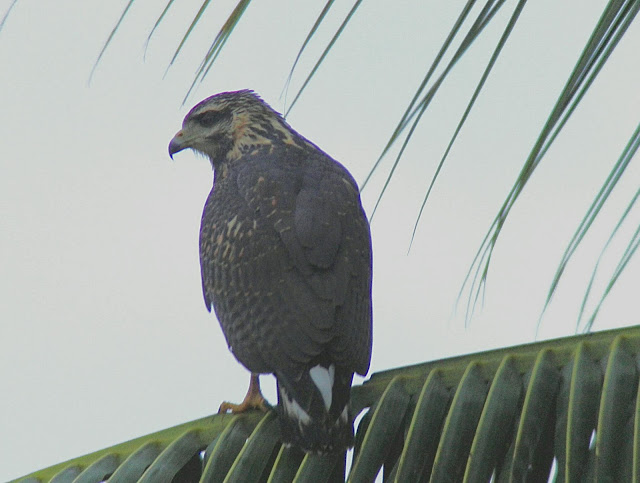The Hallowed Honeymoon Hummingbird Hunt - Costa Rica - Part 1 - The Origin of Gank
In the beginning, there was Gank.
And it was good.
The word Gank was coined by Cork birding icon, Tony "The Pig" Nagle, as a description for birds that have no relevance for Ireland.
Pretty, colourful, shiny stuff that will never, ever, ever occur there.
It's a great, great word, Gank.
My wife and I had spent a lot of time..em..."discussing" where to go on our honeymoon. Over the course of weeks we had flipped from New Zealand to Ecuador to Australia, South Africa, Trumperica..the list goes on. Finally we settled on Costa Rica.
Let there be Gank.
What a brilliant birding destination Costa Rica is. Haven't been yet? Go!
We landed in San Jose late on Saturday 12th of August, picked up our hired Hyundai Tuscon (which we named "Little Mule"), and made our way west to Tarcoles, checking into our bed and breakfast, Rancho Capulin, and crashing straight out.
Little Mule - Great for getting up them hills
Little Mule - Great for getting up them hills
We were up before sunrise, and began the short drive to the river mouth at Tarcoles. Barely 30 seconds up the road and we had our first lifer, Common Paraque. The "short drive" actually took a long time as nightjars were present along the entire route, and we had Lesser nighthawk and Short Tailed Nighthawk before reaching the beach.
As we drove down the final stretch of track to the beach, the light was edging over the horizon and Clay colored thrushes and Rufous Naped Wrens jumped on to the list.
As we stepped out of the car, ad and juv Common Black Hawks made their presence known, and birds such as Wood Stork, White Ibis, Great White and Cattle Egrets, Brown Pelicans, Black and Turkey Vultures, and Magnificent Frigatebirds, floated like Nazghul offshore.
White Ibis
Wood Stork
White Ibis
Wood Stork
As we made our way to the beach, yellow gems like Great Kiskadee, Tropical Kingbird and Grey Crowned Yellowthroat sang loudly.
Grey Crowned Yellowthroat
Grey Crowned Yellowthroat
The beach itself was surprisingly full of waders, species I would have expected to perhaps still be further north in the U.S, such as Western and Semi-palmated Sandpipers, Least Sandpipers, Semi-palmated Plovers, Willet, Greater Yellowlegs, Short Billed Dowitcher etc.
Western Sandpiper with Semi-palmated Sandpiper to it's left
Resident Rufous Collared Plovers provided more exotic fare, Brown Booby moved offshore and soon good numbers of awesome Scarlet Macaw began to leave roost, giving excellent views as they did so.
A flock of vultures fed on a washed up carcass of some variety, and brown pelicans and neotropic comorants roosted in a tight group up the shoreline.
Scarlet Macaws
Royal and Elegant Terns
This Laughing gull was the only gull of the entire trip
A juvenile Sooty tern, a fairly rare bird away from the Cocos islands, put in an appearance among all the black terns.
We made our way back to our b+b for a leisurely breakfast on deck overlooking the Tarcoles river valley, watching masses of swifts as we did so, numbering some 5 or 6 species, as well as both northern and rough winged swallow and cliff swallow.
Breakfast View
Breakfast View
Iguana
White Collared Swift
After breakfast, we made our way to Carara national park, with a quick stop at Tarcoles bridge to see these behemoths.
Look at them snappers
We paid our entrance fee, and made our way straight into the river trail. It was mayhem really. I had gone from birds I was familiar with, waders, terns etc, to new heights of Gank, whole families that were a complete mystery to me.
Lifers flowed like cheap wine at a student house party, leaving me with that inevitable feelings of dizzyness, slight nausea and, due to the dehydration, the need for a pint of water and a snack box.
After a few hours wandering the forest, we made our way back to the the main entrance of Carara, to be greeted by several of the guides in the park, directing our gaze upwards... to two King Vultures, an adult and a juv, soaring overhead. Also present were Gray Hawk and Plumbeous Kite.
Hail to the king, baby. King Vulture
Hail to the king, baby. King Vulture
King Vulture
A brief walk on the trails in this section of the park produced birds such as Great Tinamou, which gave astounding views.
Great Tinamou - Non-colourful Gank. But nice and Kiwi-like
Great Tinamou
No! YOU'RE White Whiskered Puffbird!
"Let's go offtrail." she said. "Be grand." She said. Fer de lance
Chestnut Mandibled Toucan
Fiery Billed Aracari
Some of the views from the waterfall road
Crested Guans
By the time dusk rolled around we were exhausted, and after a nice dinner and a shower to remove a day of jungle, it was essentially a birding induced coma for the night.









































Comments
Post a Comment